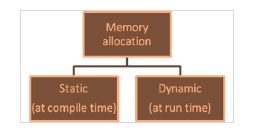C函式庫的記憶體分配函數void *realloc(void *ptr, size_t size) 嘗試重新調整由ptr指向的先前使用malloc或calloc呼叫所分配的記憶體區塊。
記憶體可以透過以下兩種方式進行分配:

#一旦在編譯時分配了內存,就無法在執行期間更改。要嘛記憶體不足,要嘛記憶體浪費。
解決方案是動態建立內存,即根據程式在執行期間的需求。
用於動態記憶體管理的標準函式庫函數如下:
#用於重新分配已分配的記憶體。
可以減少或增加已分配的記憶體。
傳回一個指向重新分配記憶體的基底位址的void指標。
realloc()函數的語法如下:
Free void *realloc (pointer, newsize);
以下範例展示了realloc()函數的用法。
int *ptr; ptr = (int * ) malloc (1000);// we can use calloc also - - - - - - - - - ptr = (int * ) realloc (ptr, 500); - - - - - - ptr = (int * ) realloc (ptr, 1500);
以下是使用realloc()函數的C程式:
線上示範
#include<stdio.h>
#include<stdlib.h>
int main(){
int *ptr, i, num;
printf("array size is 5</p><p>");
ptr = (int*)calloc(5, sizeof(int));
if(ptr==NULL){
printf("Memory allocation failed");
exit(1); // exit the program
}
for(i = 0; i < 5; i++){
printf("enter number at %d: ", i);
scanf("%d", ptr+i);
}
printf("</p><p>Let's increase the array size to 7</p><p> ");
ptr = (int*)realloc(ptr, 7 * sizeof(int));
if(ptr==NULL){
printf("Memory allocation failed");
exit(1); // exit the program
}
printf("</p><p> enter 2 more integers</p><p></p><p>");
for(i = 5; i < 7; i++){
printf("Enter element number at %d: ", i);
scanf("%d", ptr+i);
}
printf("</p><p> result array is: </p><p></p><p>");
for(i = 0; i < 7; i++){
printf("%d ", *(ptr+i) );
}
return 0;
}當上述程序當執行時,它產生以下結果−
array size is 5 enter number at 0: 23 enter number at 1: 12 enter number at 2: 45 enter number at 3: 67 enter number at 4: 20 Let's increase the array size to 7 enter 2 more integers Enter element number at 5: 90 Enter element number at 6: 60 result array is: 23 12 45 67 20 90 60
以上是在C語言中,Realloc是什麼意思?的詳細內容。更多資訊請關注PHP中文網其他相關文章!




